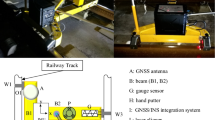Abstract
In principle, a DVL utilizes multi-beam measurements to calculate its three-dimensional translational velocity. In traditional DVL dead-reckoning navigation method, the calculated velocity is used as the AUV body frame velocity. This work proposes a novel DVL dead-reckoning navigation method in which DVL beam measurements are directly used for dead-reckoning navigation without being transformed into the AUV body frame velocity. Furthermore, the fault-tolerant strategies for situations under the constraint of incomplete DVL beam measurements are presented. In these situations, the DVL does not have sufficient (three or more) beam measurements to calculate the AUV body frame velocity, resulting in the traditional DVL dead-rocking method unusable. In contrast, the proposed method can maintain high-precision navigation with at least one beam measurement, thereby enhancing the robustness and reliability of the DVL dead-reckoning navigation system. Experiment results verify the effectiveness of the proposed method.
Access this chapter
Tax calculation will be finalised at checkout
Purchases are for personal use only
Similar content being viewed by others
References
Angel, M.J., Joshue, P. Asier, Z.: A fail-operational control architecture approach and dead-reckoning strategy in case of positioning failures. Sensors 20(2), 442 (2020)
Zhang, L., Liu, L., Zhang, L.: Research on position correction method for AUV large depth navigation based on ranging positioning. Comput. Commun. 150, 747–756 (2020)
Ning, F., Chen, Y.: Combining a modified particle filter method and indoor magnetic fingerprint map to assist pedestrian dead reckoning for indoor positioning and navigation. Sensors 20(1), 185 (2019)
Stutters, L., Liu, H., Tiltman, C., et al.: Navigation technologies for autonomous underwater vehicles. IEEE Trans. Syst. Man Cybern. Part C (Appl. Rev.) 38(4), 581–589 (2008)
Paull, L., Saeedi, S., Seto, M., et al.: AUV navigation and localization: a review. IEEE J. Ocean. Eng. 39(1), 131–149 (2014)
Kinsey, J.C., Eustice, R.M., Whitcomb, L.L.: A survey of underwater vehicle navigation resent advances and new challenges. In: Proceedings of IFAC International Conference on Manoeuvring and Control of Marine Craft. Lisboa, Portugal (2006)
Acoustic Doppler Current Profiler Principles of Operation: A Practical Primer, 2nd ed. pp. 3–8. RD Instrum. Co., CA, USA (1996)
Klein, I., Diamant, R.: Dead reckoning for trajectory estimation of underwater drifters under water currents. J. Marine Sci. Eng. 8(3) (2020)
Wang, T., Zhou, L., Sun, J., et al.: Navigation error model based on SVM for UUV’s dead reckoning. Ind. Control Appl. 33(5), 22–25 (2014)
RTI ADCP/DVL USER GUIDE, pp. 56–57. Rowe Technol. Inc., CA, USA (2016)
Liu, P., Wang, B., Deng, Z., et al.: INS/DVL/PS tightly coupled underwater navigation method with limited DVL measurements. IEEE Sens. J. 18(7), 2994–3002 (2018)
Tal, A., Klein, I., Katz, R.: Inertial Navigation System/Doppler Velocity Log (INS/DVL) fusion with partial DVL measurements. Sensors 17(2), 415–434 (2017)
Yao, Y., Xu, X., Li, Y., et al.: A hybrid IMM based INS/DVL integration solution for underwater vehicles. IEEE Trans. Veh. Technol. 68(6), 5459–5470 (2019)
Wang, D., Xu, X., Yao, Y., et al.: A hybrid approach based on improved AR model and MAA for INS/DVL integrated navigation systems. IEEE Access: 82794-82808 (2019)
Author information
Authors and Affiliations
Corresponding author
Editor information
Editors and Affiliations
Rights and permissions
Copyright information
© 2022 The Editor(s) (if applicable) and The Author(s), under exclusive license to Springer Nature Singapore Pte Ltd.
About this paper
Cite this paper
Liu, P., Hou, D., Wang, K., Wang, B. (2022). DVL Dead-Reckoning Navigation Method Based on Beam Measurements. In: Yan, L., Duan, H., Yu, X. (eds) Advances in Guidance, Navigation and Control . Lecture Notes in Electrical Engineering, vol 644. Springer, Singapore. https://doi.org/10.1007/978-981-15-8155-7_104
Download citation
DOI: https://doi.org/10.1007/978-981-15-8155-7_104
Published:
Publisher Name: Springer, Singapore
Print ISBN: 978-981-15-8154-0
Online ISBN: 978-981-15-8155-7
eBook Packages: Intelligent Technologies and RoboticsIntelligent Technologies and Robotics (R0)




